
BEYOND THE ZIGZAG PATH. Where is the Friend’s Home?
BEYOND THE ZIGZAG PATH. Where is the Friend’s Home?
(A. Kiarostami, 1987), Thirty Years Later[1].
FARSHAD ZAHEDI[i]
Universidad Carlos III de Madrid
DOI: http://dx.doi.org/10.15366/secuencias2016.43-44.003
[i] FARSHAD ZAHEDI is a Doctor in Film History and a professor in the Department of Journalism and Audiovisual Communication at the Carlos III University of Madrid. Among his publication on Iranian cinema, the following stand out: «Cine iraní en España» (Estudios sobre el mensaje periodístico, 2015. vol. 21, n.º 2) pp. 1295-1308, «The Myth of Bastoor and the Children of Iranian Independent Cinema» (Film International, 2014, vol. 12 n.º 3), pp. 21-30; «Figuras femeninas en el paisaje urbano: La tetralogía de Dariush Mehryui» (Archivos de la Filmoteca, n.º 67, 2011) pp. 82-95; 40 años de cine iraní: el caso de Dariush Mehryui (Madrid, Fragua, 2010) y «Irán, cine y modernidad» (Revista de Occidente, n.º 343, 2009) pp. 33-53.
Abstract:
The majority of reviews and analysis of Where Is The Friend’s Home (Janeh-ye dust koyast, Abbas Kiarostami, 1987) have remarked the metaphysical dimension of the movie. The voyage of a child eager to find his friend’s home, has been interpreted as an initiation journey of a premodern subject. The approach to the exotic aspect of the movie has obfuscated the interpretations within its own historical context, and has diverted, instead, the posterior construction of the meaning for the movie, toward extradiegetic terrains. Whereas the inherent modernity of the Kiarostami’s narrative was ignored, the movie was interpreted as a visual esoteric poem. This dominant approach is not enough for analysing the sociohistorical aspect of the movie, especially visible and interpretable in a key sequence, which was ignored.
Keywords: Iranian Cinema, Kiarostami, Koker trilogy, Where is the Friend’s Home?, doors and windows.
Introduction
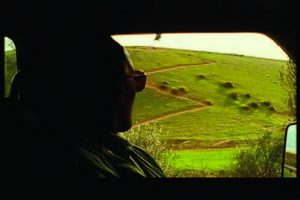
Abbas Kiarostami: truths and illusions (Abbas Kiarostami, vérités et songes, Jean-Pierre Limosin, 1994).
The protagonist child of Where is my friend’s home? crosses a zigzag path several times to cross the hill that separates his town from the neighbouring village. Leaving behind a lonely tree at the top, the boy would enter the neighbouring village’s territories, reach his friend’s house, and be able to hand over his homework notebook. But the reality is quite different. Outside of the diegesis of the film, the path goes nowhere. Kiarostami stated that the zigzag road was built by the village children on the occasion of the film during the filming and that its end point is the top of the hill where the famous solitary tree was also planted: «that road is one of those that have no end, but at the same time can lead one to many places […]; at least, this one in particular took me to many places […] It was miraculous for me »[2].
The image of the hill, the zigzag path and the lonely tree reappear in two other films in the famous Koker trilogy. Kiarostami’s naturalism draws much attention from European critics. Lonely trees and zigzagging deserted roads have since abounded in all of the Iranian director’s work. Even for some critics they were important elements of his signature. Abbas Kiarostami was recognized as the author of roads, trees, lonely seekers and dialogues in the car. Elements that were recognized as structuring of his work. Some authors even find a certain resemblance between the image of the hill, the zigzag path and the solitary tree with the masterful Persian miniatures. For Joan Copjec, Kiarostami had inserted into Koker’s trilogy a replica of The Xvarnah Landscape, the masterful miniature from the 14th century made in Shiraz, defined by Henry Corbin as a sample of the Persian worldview, “a visionary geography”, a place between the abstract and the sensible[3]. This recognition was probably the miracle of the zigzag road that Kiarostami spoke of.
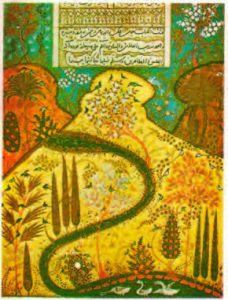
Landscape “Xvarnah”, from Persian Anthology, manuscript dated 1398. A.D. Museum of Turk ve Islam Muzesi, Istanbul.
The impression made by the second and third parts of the trilogy, And life goes on (Zendegi edameh darad, 1992) and Through the olive trees (Zir-e derajtan-e zeytun, 1994), led French critics to return a Where is my friend’s home? —a film that in its limited video distribution in 1990 did not attract much attention— and soon a metaphysical reading of the film became the starting point for Abbas’s sense of authorship in Abbas Kiarostami[4]. Where is my friend’s home? was seen as full of symbolism. The usual political readings of the film, highlighting a micro-cosmic space in the narrative, very close to the discovery of Sohrab Sepehri’s poem by French critics, gave rise to a cultural reading for which the image of the zigzag path and the solitary tree – within all that the translation of Sohrab Sepehri’s poem offered – were widely recognized as the reference points and the keys to interpreting the symbolic space of the film.
Where is my friend’s home? It is not the first Iranian cinema film to be awarded at international festivals, but its discovery by European theorists and critics places Iranian cinema on the world cinema map. The film marks a before and after in the author’s career, who from then on gradually abandons conventional narrative elements to increasingly practice a radical and antagonistic aesthetics to that of mainstream commercial cinema. We can interpret the miracle of the path, therefore, as the visual element that opens the door to a reading of the creator`s personality. In other words, the zigzag path and the lonely tree contribute greatly to Abbas Kiarostami’s construction as an author.
This article proposes a new reading of Where is my friend’s home? The passage of three decades since the film’s production provides us with a certain historical perspective. But this review, necessarily has to include the circumstances in which the Kiarostami feature film arrives in Europe. Likewise, it is also important to analyse how the film was discovered by international critics and how a meaning was constructed for its reading. The final objective of this study is to make the historical aspects of the film visible. In this sense, it seems important to return to other – almost ignored – visual elements such as doors and windows. Present throughout the film, especially in a key and less discussed sequence, doors and windows exist at the centre of the village’s social conflict. This calls into question the mere esoteric readings of the feature film and emphasizes a need to rethink the film.
Who are you Mr. Kiarostami?
Chronicle of a discovery
In its first European screenings, probably no one imagined that Where is my friend’s home? in a few years would become a paradigmatic case[5]. The case of Kiarostami at the Locarno festival in 1989 would have remained anecdotal if the second and third installments of Koker’s trilogy – And Life Continues and Through the Olive Trees – had not reaffirmed the particular aesthetic of the filmmaker and had not transcended as a true discovery in European festivals. In France, the premieres of Close-Up (Nema-ye Nazdik) in 1991 and Life goes on (Zendegi va digar hich) in 1992, led Positif magazine to prepare extensive dossiers and interviews about Kiarostami together with articles on his bio-filmography and on the history of Iranian cinema[6]. The premiere of Across the Olive Trees reaffirms the need to offer a point of reference to observe the works of Kiarostami and a return to the point of origin of the same: the village of Koker in Where is my friend’s home? Godfrey Cheshire notes that the Koker trilogy has been crucial to understanding the author’s career: “in each installment of the Koker trilogy, viewers who have seen previous films know how much — subtly and convincingly — they influence understanding of the movie you are watching »[7]. The film space of the three films is the same area in the vicinity of the Caspian Sea; the characters of each film appear in the next installment in a kind of self-referential intertextuality; and the common elements such as the paths, glances, voice-overs and above all, the famous game of repetitions, the zigzag path and the lonely tree appear in each of the three films. Something indicated that Abbas Kiarostami, upon returning to the scene of the film that started his international career, brought the audience’s attention to the space and recognizable characters of the Koker from Where is my friend’s home?

Cover of Cahiers du cinema (No. 493, July-August 1995).
In 1995, the forceful reaction of Cahiers du cinéma in the form of its famous dossier «Kiarostami le magnifique» carries the image of Kiarostami against the background of the so-called cosmic plane of Through the olive trees on the cover of the magazine. The image left no one in doubt: a new author has been born and a new peripheral cinema has been discovered that must be mapped[8]. An image of Where is my friend’s home? along with the words “Who are you Mr. Kiarostami?” open the space of the dossier, on the inside pages of which is the article by Laurent Roth that offers the key to reading Where is my friend’s home? in Sohrab Sepehri’s poem The Address. Altogether with the French translation of Dariush Shayegan’s poem, in the dossier appear its transcription in Persian, a map of Iran on the surface of which stand out notes and sketches of the exact location of the Koker village, and a sample of Persian calligraphy. Sepehri’s poem takes Roth further when he discovers that the slight distortion of the translation of the French title, Where is my friend’s home? rather than the original title of the film and its namesake first verse of Sepehri’s poem «Where is the friend’s home?» Had been the initial cause of a confusion that had led some critics to an interpretation of the film within the grounds of «realism»:
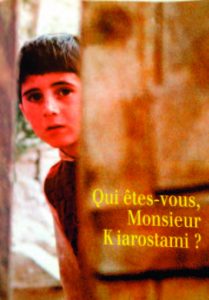
Home page of the Cahiers du cinema dossier (No. 493, July-August 1995) dedicated to Kiarostami.
Shayegan’s translation allows us to see that the title is a search for the friend’s house, not my friend, and consequently we have to ask ourselves, which Friend are we talking about? […] when [Ahmad] learns of his serious role, the Amigo with capital letters enters the scene […]. Here, the existence of the Friend himself is the heart of that journey of initiation. When Ahmad arrives in front of the friend’s house, he hesitates, gets scared, and turns around. That is why the notebook, the lost object, does not reach its consignee. Here, secretly, as a lesson from the poem, it is the child who arrives a few steps away from the flower of loneliness and is warned for never having to look for the Friend’s house […]. This knowledge is undoubtedly the result of an initiation, of the symbolic, of not wanting anything, of the incomplete, of the desire itself. Here comes the messianic expectation of the “Friend” which is one of the names of the Prophet. Sepehri knew it very well. He is an inspired libertine of Persian poetry, an esoteric mystic, an opponent of the Pharisaic tradition of Islam, the doctors, the censors, and the inquisitors. Kiarostami, by embodying the spirit and the letter of the poem with such freshness, undoubtedly signs such a beautiful and mystical film[9].
Roth’s error in attributing the term «Friend»as one of the prophet’s names is secondary[10]. Few are the authors, namely, who have used it subsequently, but what is important, and from then on becomes the dominant reference of the interpretations, is the meaning that Roth constructs for the film: the journeys of Ahmad, his comings and goings to the neighbouring village in search of his friend’s house were defined as elements of an initiatory journey. The friend was defined as an abstract concept, a metaphysical entity outside the historical scope, and the film, as a sample of the esotericism of Kiarostami, following in the footsteps of his predecessor Sepehri by taking refuge in a kind of nature cult aimed at denouncing the dominant political system[11].
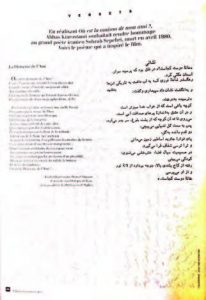
Sohrab Sepehri’s poem, The address: (Cahiers du cinema No. 493, July-August 1995).
Reading of Roth greatly influences other authors’ comments and analysis on the film. It is in Italy and Spain where the first resonances appear. In parallel, some Iranian authors residing in Europe reaffirm Roth’s interpretation by attributing to Kiarostami a kind of mystical praxis. In this sense, regarding the term «dust», «friend», Youssef Ishaghpour points out:
The friend among the Persian mystics is one of the names of God. Therefore, there is an identity between the friend and God, hence the expressions: «the path of the friend»”, «the house of the friend». Here, in this boy’s story, this path in search of the friend’s house is like a real «search». In a simple incident, there is of course a «duty of friendship» in the oppressive world of the elderly, with its contradictory, often absurd demands and fundamental misunderstanding[12].
Ishaghpour also considers the old cabinetmaker, the only character who helps Ahmad, as a spiritual guide, a kind of wise old magician in the style of Pir-e Mogan de Hafez[13]. The end of the film for Ishaghpour is the moment of enlightenment, when the boy realizes the impossibility of his search: «According to good tradition, the external search for the friend’s house must fail, since “the friend’s house” is none other than one’s own house, which one has to find in a sad and dark corner of his own heart»[14]. Identical is the case of the text by Sussan Shams, in which the author, regarding Abbas Kiarostami’s cinema, offers an encyclopaedic compendium of the basic concepts of Eastern philosophy, as well as the keys to the aesthetics of the Iranian author’s cinema. As for the zigzag path, Shams points out that this image comes:
from the image of «the spiral» that we find in the painting of the Muslim world as the secret of the space organization […], a very materialization of esotericism in art […], it is a symbol of eternal bliss […] and, indeed, it is the spiritual path that connects man to the divine, to the «supreme truth». In other words, it is the metaphorical image of the mystical path-search[15].
Shams finds the meaning of the solitary tree within the Persian mystical tradition: «it represents the two antagonistic poles of the world, the recklessness of ignorance and the light of divine knowledge»[16]. For her, this duality is rooted in the very existence of the tree: on the one hand, it has its roots in the darkness of the earth, and on the other hand, it has the trunk and leaves facing the daylight.
Kiarostami, Sepehri, little Ahmad and the cult of nature.
The pulse of time and lonely trees
From the United States, Hamid Dabashi, on his part, believes in a similarity between the main character of the film and the author himself. He regards Ahmad as Kiarostami’s alter ego and Kiarostami as a cinematic counterpart to Sepehri[17]. The search for the key to the construction of the meaning of Where is my friend’s home? It would lead us to this alter ego game that Dabashi believed in: Ahmad, Kiarostami and Sepehri are one and the same thing. The choice was Sepehri, whose work, in the opinion of some authors, somehow structures the meaning of the film. The poet’s pantheistic style, his metaphysical vision of nature and his hieratic perception of time, among others, were considered an essential component to understand Kiarostami’s feature film and to understand the vicissitudes of Ahmad in search of his friend’s house. Hence the lone tree at the top of the hill on the zigzag path was considered a key feature.
In an interview with Abbas Kiarostami regarding his photographs of trees, he tells of his affinity for nature and especially his secret and intimate dialogue with the trees that are the object of his photographs:
I have the feeling that trees are the individuals who share our destiny, that they can be lonely, sad, isolated. Sometimes I have the impression that a dialogue is established between them and me, in which we are aware of certain things. Sometimes it is like if seeing me they would say to themselves: «look, he has arrived with a new camera» […] Perhaps these repeated visits contributed to my close and intimate relationship with this particular place […] In front of these photos today I have the feeling of being in front of an old photo of schoolmates after many years. I can tell the fate of each one[18].
There is a clear tendency for the author to portray trees in his filmography. It is not surprising that trees were the recurring elements of his photographs and that they appeared in the title of two of his most successful feature films: Through the Olive Trees and The Taste of Cherries (1996). Again, it is Youssef Ishaqpour who, in a conversation with Kiarostami, expresses his interpretation, considering this naturalism as a reflection in a mundus imaginalis:
Y.I: In some of your photos, nature becomes […] [in] an «eighth climate», a «no place» that Iranian mystics spoke of. And what is transitory becomes what is on the other side of death […] [in a] resurrection in the world of the image.
A.K: Yes, but that is not a decree, a primordial truth or a fact, but a wish, [simply] a wish[19].
On one occasion, about the lonely tree in Where is my friend’s home?, the filmmaker is attributed a statement in which he considers that the tree in Persian culture is a symbol of friendship[20]. But it seems that here we are faced with a double case of lost in translation, since neither the tree in the Persian culture is the symbol of friendship[21], nor is the friend exactly one of the names of God[22]. Regarding the concept of Sepehri as a mystical poet, there also seems to be a similar case. Sepehri was introduced to the West by Dariush Shayegan’s interpretation of his life and work. Reading Shayegan made it easy for critics to find a certain resemblance between the works of the poet and painter Sohrab Sepehri and the works of Abbas Kiarostami. Both Sepehri’s paintings of lonely trees, and his poetry a la haiku, marked by the metaphysical dimension of nature, led the authors to find something else behind the title of the Kiarostami film. The event was especially remarkable for the initial label in Where is my friend’s home? dedicated to the memory of Sohrab Sepehri. Shayegan’s prologue becomes important, as it offered clues to the interpretation of the film. For him, Sepehri’s poems establish «a mystical contact with nature, a generous pouring out in the secret rhythm of each pulse that animates men and things and a nostalgia for origins»[23].
In the speculative journey of international authors in search of the meaning of the film in the Sepehran universe, the most important thing remains intact: the inherent modernity of Sepehri’s poetry. Even Shayegan’s own comments on the image of nature found in almost all of Sepehri’s works were ignored: «This way of capturing nature is alien to Persian poetry […] it will be [rather] reinforced for his long stay in Japan and his studies of Chinese-Japanese poetry and art»[24]. Likewise, Shayegan points out that Sepehri «lived long periods in France (Sepehri knew French perfectly) and in the United States» and positions Sepehri’s mysticism in line with the thinking of the great contemporary thinkers and poets, from TS Eliot, Wallace Stevens , Rainer María Rilke, R. Char, to M. Heidegger, M. Bube. CG Jung or E. Neumann, who in Shayegan’s opinion «strive to recover, in the absence of all divinity, on the ruins of cultural canons, in this world reduced to a desert (Wasteland), a suitable base to found our disenchanted world »[25]. From this point of view, it seems that reading the film as analogous to Sepehri’s universe, reducing the poet to a mere Persian mystic, simplified the reading of the film according to the old orientalist canons. In any case, the «ignorance» that Shayegan pointed out was evident, and the case of Kiarostami, again, confirmed it: «The unheard of message of the great Persian literature has never been known in the West»[26].
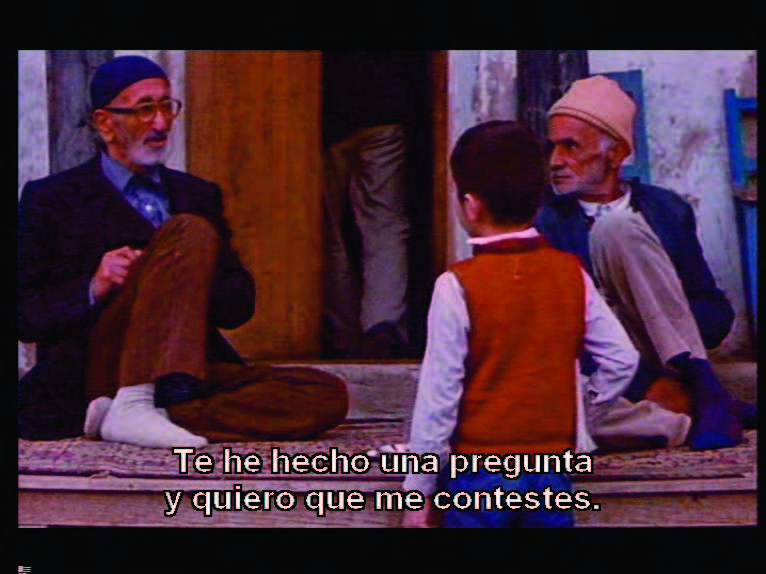
The key sequence (1)
The scene of the confrontation
Interpretations in the key of Sepehri’s poem do not seem sufficient to analyse socio-cultural aspects of the film. Where is my friend’s home? was made at an important historical moment, but the metaphysical readings, above all, ignored this historical link. At the same time, the film was seen from an idyllic vision – a kind of orientalism – that attributed a mystical quality to it. Ahmad’s journeys were thus reduced to a journey of initiation and the film was defined as an esoteric hymn to friendship. This ahistorical reading could surprise any «close observer» who knew the intellectual concerns of the generation of artists to which Abbas Kiarostami belonged. The metaphysical view could explain the images of the lonely Ahmad in the midst of nature – hence the incessant emphasis on the zigzag path and the lonely tree – but it was insufficient for the analysis of the scenes of the child’s conflict with adults.
It seems necessary to return to a key sequence of the film that has hardly been mentioned in the comments and analysis of the film. It is about the scene in which Ahmad directly confronts the male circle of the village. First, he confronts his grandfather and then accidentally gets caught up in the middle of sales negotiations of windows and doors. Ahmad’s meeting with his grandfather has been analysed by some authors as the confrontation of the new generations with the social system:
Ahmad’s transgression should not be seen as a simple and anecdotal escape in search of his friend’s house, but as an authentic rejection of the suffocating order of a patriarchal system governed by the weight of traditions, of a closed order that reproduces on a small scale the rules of the game of an oppressive society[27].
From this perspective, Ahmad’s transgression can be seen as the source of his childhood identity. His personality is formed by resistance to the prevailing order. He — like many other Kiarostami characters — finds flexibility an effective strategy to avoid punishment. This is also his Kafkaesque conclusion of finding in the lie an irremediable impulse and a universal principle. Transgressions of the patriarchal law are also grounds of pleasure to little Ahmad[28]. This pleasure would only take life if it is communicated and shared to shape a primordial human sense: solidarity. Ahmad’s loneliness is not only because he does not find anyone who is really capable of helping him, but because he does not find anyone with whom he can share that pleasure of transgression. He does not even get to share with anyone the glorious moment of finding an effective solution to deceive the teacher until very late in the film, when the frozen image of the dried flower in the middle of the notebook puts an end to the odyssey of this «child wise »[29].
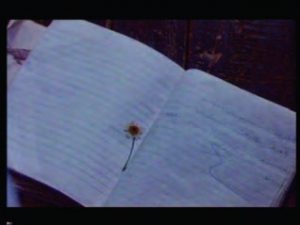
Final shot of Where is my friend’s house?
This fact of Ahmad was seen by some authors as a sign of liberation. Emanuela Imparato, comparing Ahmad to the protagonist of Kafka’s story The Sudden Walk, sees Ahmad’s transgression as the necessary cost he has to pay to leave the suffocating space of the family and change the old order with something new. Imparato, like many other authors, relates the film to the political context of Iran: «little Ahmad frees himself from the limitations of a family that repeats in the microcosm of parent-child relationships, the macrocosm of social politics, religious Islamic, governed by eternal laws»[30]. The authoress considers that the closed universe of the film is an indication of the social context of Kiarostami, and considers that Ahmad’s journey is like a metaphor in which, contrary to the context of Kafka’s novel, freedom is not only possible in the dream, but in the outside world, where the child can go out and have the possibility of finding his friend’s house[31]. Alain Bergala, for his part, regarding the sequence, points to the socio-cultural dimension of the scene. For Bergala, one of the structuring themes of Abbas Kiarostami’s cinema is the question «of the law and its transmission»[32]. Bergala also relates this recurring question of Kiarostami’s work to one of the less discussed aspects of his «signature» and considers it a reflection of his socio-political context:
In a country like Iran, where there is a religious law that demands political power, thus repression and the tyrannical control of freedoms exonerate themselves from all direct responsibility; everyone is unconsciously involved as a vector of law transmission[33].
Bergala returns to the romantic vision of authorship – according to which the author is the one who has perfect control of his work – to see the key to Abbas Kiarostami’s survival in the oppressive system of local censorship. For Bergala, the author avoids portraying a character who is directly opposed to the law, and at the same time constructs characters who, when in contact with the law, were capable of «making fun of it without drawing much attention»[34]. Bergala believes that Kiarostami’s films reflect attempts by simple characters not to become blind agents of the law. This is how little Ahmad’s confrontation with the adults of the village makes sense, who for Bergala are passive agents of traditions and of a law that «repeats itself in an identical, [rather] mechanical way, from generation to generation, increasingly frozen in its rigidity […] [against which] the only solution that remains […] is to transgress it in the name of a higher, intimate and stronger law »[35]. Within this vision, Ahmad’s trip to Bergala finds its meaning: «Ahmad lives in Koker, from where the famous Z road was built on purpose for the film by the film crew, and which will become a mythical place. He will have to leave this familiar place, defying prohibition and facing the law»[36].
The key sequence (2)
A hymn to solidarity
The Bergala and Imparato readings frame Ahmad’s confrontation within a political framework. Given that the film does not offer any direct political references, it seems somewhat forced to regard Ahmad’s confrontation with the elders as a mere sign of socio-political disputes in the Iran of the 1980s. Furthermore, this rather local reading, although it could serve to «celebrate the difference»[37], would undoubtedly overshadow any path towards universalistic interpretations of the work. That is why a return to the key sequence of the film seems necessary in order to carry out a historical-cultural review.
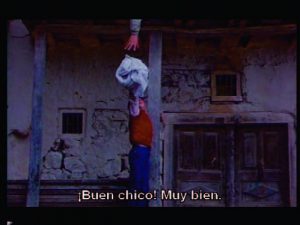
The Solidarity!
To begin with, we must point to solidarity as the apparent predominant theme of the film. Ahmad finds it very easy to search for the home of Mohammad Reza, the classmate he hardly knows. Returning the homework notebook to Mohammad Reza would avoid another distressing moment in the classroom. But, at the same moment in which he plans the trip, he is in a hostile universe where symbolic violence is the bargaining chip. It is not as easy, as Ahmad probably thought, to find Mohammad Reza’s home in the neighboring village Poshteh. As in Koker, in Poshteh no one pays attention to children, and therefore, even though his friend’s last name is one of the most common surnames in the village, no one knows him exactly. On the other hand, the price that Ahmad has to pay to avoid violence in the classroom is to receive the same violence: the punishment that awaits him at home, the scorn of his grandfather and Agajan – the burly intermediary of the sale of doors and windows — and the general disdain of adults for his request for help. Ahmad, like Kafka’s Josef K., finds himself immersed in a social order that fundamentally ignores the sense of solidarity[38].
Ahmad’s confrontation with the elders in the chaijaneh sequence leads him to the core of the impasse of solidarity in a world dominated by the logic of profit. A psychoanalytic reading of the film would lead us to the conclusion that only repressed groups can share the primordial pleasure of solidarity, and therefore any aspect of solidarity must be understood as false —or in the best of cases as a charitable act— from the dominant ideology to the repressed groups. In other words, the child’s solidarity with his friend is not only to help him, but to communicate the violation of the prevailing law. In this way, by sharing the pleasure of transgression, solidarity gets formed and takes force. However, this pleasure could only be shared with another child, or with another repressed social group. In this key we must understand Ahmad’s dialogue with the old cabinetmaker, the help he receives — still futile and sterile — from the village women and from other children. In this sense, Ahmad moves in a pre-ideological space of solidarity, in which his request for help from a colleague is based more on his own sense of guilt than on a pure sense of friendship. He has been the one who has mistaken his friend’s notebook with his own. Ahmad, more than guilty, is the victim of the situation, but he still goes out in search of his friend, mostly to make up for the mistake he made. He, most likely, does not yet have any consciousness of a universal value called solidarity, and therefore does not declare his act in an ideological framework either. In other words, he, under social circumstances, becomes the active agent of change and thus encounters enormous obstacles in his way. Ahmad looks for an effective way to change the destiny of his friend, who, if he does not write his homework in his own notebook, will be expelled from school. The energy that leads him to make the act of approaching the «other»is simply his own guilt that materializes in the notebook[39].

The notebooks are identical!
Another issue that comes into question here is the pleasure principle. The transgression of the law provides a pleasure that in itself is the structuring dimension of solidarity. Under this premise, we can once again see the exploits of Ahmad, whose pleasure in transgression seems contrary to that propagated by the dominant ideology[40]. From this perspective, Ahmad’s sense of duty —returning his friend’s notebook, receiving punishment in exchange for breaking parental-child law, and having no one with whom to share the pleasure of transgression— enters a mythical dimension.
The bitter aspect of Ahmad’s trip is his loneliness. The old cabinetmaker, the only character who helps him, was compared in some texts to the mystical Pirs spirit guides of ancient Iran. The cabinetmaker conveys to Ahmad his nostalgic vision of the town’s history and tries to communicate his ideal of going back to the past to recover the lost art of wooden windows and doors. An impossible task of which the film is clearly aware. The knowledge that the cabinetmaker transmits to Ahmad will help the child later to find his place in history, but the cognitive map that the cabinetmaker tries to draw is long out of date. He, who knows the town by the doors and windows it has built, with the arrival of the iron gates and the disappearance of his works, has lost his references. Their help is of no use to Ahmad, who is seeking an effective solution to the problem.
The key sequence (3)
The door
It is now when you have to go back to the doors as a vital element of the film. Despite the author’s own statements[41] and notes from some theorists, gates as important «signifiers» have been almost completely ignored. Jean Luc Nancy’s point seems obvious when considering that the door is present in the whole film «as an opening to a space or to a world»[42]. However, the film’s emphasis must be sought on this transitional space, the door, within the film itself. Where is my friend’s home? begins with a close-up of the worn classroom door, the one that barely closes and remains ajar, causing the viewer to feel uneasy due to the teacher’s repeated failed attempts to close it. The classroom door hints at an urgent need for repair or replacement. Soon after, the door becomes the object that causes desire in the boy, when he begins his constant search for the door of his friend’s house. No less important seems the business of buying and selling doors and windows in the centre of the village. Thus, the essential change in the structure of the town is highlighted. The fact is the reason for the complaint of the old cabinetmaker, who once built almost all the gates of the village. His traditional art disappears little by little with the arrival of the new iron gates that seem very profitable for the new speculative economy of vendors like Agajan. The cabinetmaker says that the old wooden doors end up in the city’s antique market. Among so many doors in the Poshteh village, among which are still the works of the cabinetmaker, there is one that would serve Ahmad to avoid the expulsion of his friend and calm his sense of guilt, but it is not possible to find it. In this sense, the pantheism of Sepehri’s poem seems totally secondary and serves only as the backdrop for a flow of events that silently transform the life of the village and its inhabitants, including little Ahmad, his family and his friend Mohammad Reza[43].
The key sequence (4)
Agajan’s business
Ahmad’s absence from the screen during the first part of the chaijaneh sequence leaves the narrative space without the sole bearer of the sense of solidarity. In Ahmad’s absence, the grandfather offers his pedagogical plea, paying homage to punishment as the most effective way of correcting disobedience. In the second part of the sequence, Agajan’s door business enters the scene.
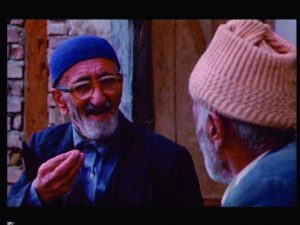
Grandfather’s pedagogical plea
When Ahmad reappears, Agajan asks him for a page from his notebook in order to write a receipt. Thus, the notebook, this MacGuffin from the film, the object that materializes Ahmad’s guilt and the site of the confluence of various social meanings, enters the business. After the little boy’s reluctance to leave the notebook, Agajan takes it from him with authority. Everything changes for Ahmad, turning his sense of resistance into a deep curiosity, when he realizes that Agajan’s last name is Nematzadeh, like his friend Mohammad Reza and therefore may be the father of his friend. Agajan’s behavior, despotic and authoritarian, indicates his social situation. The authority of the grandfather in contact with him is completely blurred and remains in the background. Agajan and his door business seem like the center of gravity of the town’s economy.
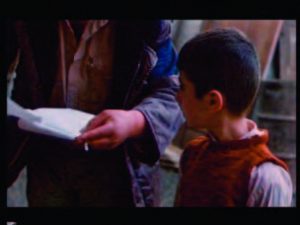
The notebook goes into business.
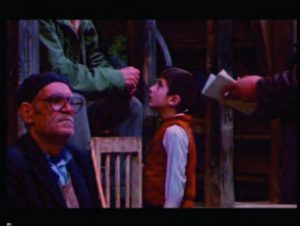
Organs without bodies! The voices seem autonomous.
Ahmad’s shot, when he stands between Agajan and his interlocutors and asks them endlessly if they know Mohammad Reza – they categorically ignore him – represents the traumatic dimension of the scene. In the middle shot where Ahmad, looking at Agajan and his interlocutors, begs for their attention, Agajan’s head is out of shot. In other words, Agajan and his interlocutor appear headless and the voices seem to have no owners. They seem autonomous voices, bodies without a body[44].
At the end of the business, Agajan rides his mule back to Poshteh and brings the windows to the buyer. Ahmad runs after him to cross the zigzag path again, the lonely tree, turn the hill and enter the neighbouring village. Ahmad’s anguish every time he crosses the road does not resemble the messianic image that has been attributed to him in some interpretations. Time does not run in favour of a child who is aware of the punishment that awaits him at every corner. The search for his friend’s house is not solved by crossing the road again and again, but leads him to the heart of the village darkness: the social system in which all adults are immersed. The knowledge that he achieves after the apparent initiatory journey is not of a sublime and spiritual character, but of a purely material nature. The object in his hand, «the lost object» according to Laurent Roth[45], has to reach its addressee.
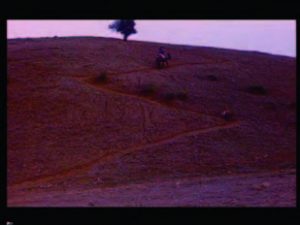
The zigzag path and the lonely tree.
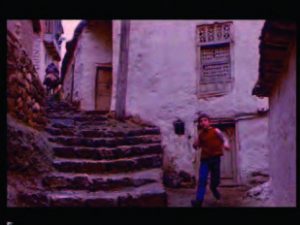
Again, Ahmad in Poshteh.
Once Ahmad reaches Poshteh again he realizes that Agajan is not the father of Mohammad Reza, but certainly he does have a son his age, who gives him new clues to find his friend’s house. Following new leads, Ahmad meets the cabinetmaker[46]. The cabinetmaker’s statements, when he points out that he knows all the people of Poshteh and Koker since he has made all the doors, give Ahmad new hope. But the old man’s indications also end up being another illusion. The old cabinetmaker assures Ahmad that he knows the Nematzadeh, and that he will lead him to the door of the house he seeks. His nostalgic discourse regarding his art about to disappear, his lament for the current trend of change, his denunciation of the hegemony of the iron gates and his distrust of the speculative economy of his crafts are of no use to an anxious child who among the many doors built by him, he looks for just one, his friend’s.
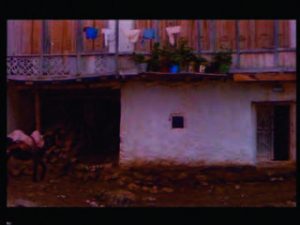 There comes a time when the child has to follow all alone the last steps, since the cabinetmaker cannot accompany him anymore due to fatigue and exhaustion. Ahmad follows all the instructions of the cabinetmaker – his spiritual guide, according to some texts – and realizes that he has brought him back to Agajan’s house, this time immersed in darkness[47]. The help of the cabinetmaker remains a futility. His solidarity ends up being a sterile friendship equal to those that Kiarostami – as Alberto Elena had very lucidly detected – has portrayed so many times in his films[48].
There comes a time when the child has to follow all alone the last steps, since the cabinetmaker cannot accompany him anymore due to fatigue and exhaustion. Ahmad follows all the instructions of the cabinetmaker – his spiritual guide, according to some texts – and realizes that he has brought him back to Agajan’s house, this time immersed in darkness[47]. The help of the cabinetmaker remains a futility. His solidarity ends up being a sterile friendship equal to those that Kiarostami – as Alberto Elena had very lucidly detected – has portrayed so many times in his films[48].
All the clues seem false. Ahmad is unable to find his friend’s house and no one, not even the old cabinetmaker, is able to help him. With respect to old cabinetmaker

The cabinetmaker returns Ahmad to the front of the Agajan house.
and the visions that considered him a Pir, a Morad (spiritual mentor), Naser Zeraati seems to be the first to deny it:
In Where is the friend’s home? do not look for a kind of mysticism […] In this film there is no trace of a initiatory spiritual journey. The old cabinetmaker is not a spiritual master, nor is he a Morad. He, with his deep roots in the past – a glorious past whose beautiful and colourful resonance is still visible on the walls and alleys of the village – despite his desire to hide his deep sadness and loneliness after a nostalgic return to life past, he confuses his poor and innocent Morid [apprentice] and leads him in the wrong direction, and unconsciously, later abandons him to his fate in the midst of darkness and storm[49].
The sterility of the cabinetmaker’s help is not to be viewed as anecdotal. It seems that the film casts certain doubts about the efficacy of his nostalgic idea that tries to promote in the child a return to the past in order to recover the lost traditional art.
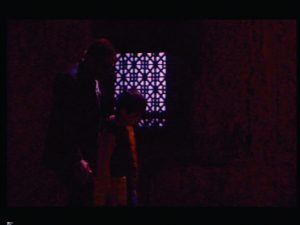
The nostalgic speech of the cabinetmaker.
This idea of going back in history, a conscious denial of the present, had a strong presence in the political space of Iran in the 1980s. The dark passages around the return from Agajan’s house to Koker seem semiotic indications of a certain obscurantism. Given the impossibility of this travel in time, the knowledge of the old cabinetmaker is not effective today either. Its references belong to a past time that has disappeared. Not only is the cabinetmaker unable to help Ahmad, but he will lead him back to the house of Agajan, the current power of the village, and who, according to his own critique of the present day, is the active – and noxious – agent of the sudden changes in the morphology of the town. Agajan and the cabinetmaker are heads and tails of the same historical coin.
Conclusions
Where is my friend’s home? fits perfectly into what Bill Nichols had described in his study as a «window into another culture»[50]. The simple journey of a boy who, in search of his friend’s house, crosses natural landscapes and speaks an exotic language, stimulated the orientalist fantasy of «distant observers»[51]. The starting point of almost the majority of texts written about the film is an experience – and a celebration – of difference[52]. Therefore, the film was presented as an exotic object, whose function was primarily the construction of the authorship of Abbas Kiarostami in retrospect. This approach has overshadowed an interpretation of the film within its historical context and in turn has diverted later constructions of the film’s meaning into extra-diegetic grounds: the exotic of Sepehri’s poem or the political context of Iran. In other words, in this starting point of the construction of the authorship of Abbas Kiarostami, the film and the narrative itself have not been dealt with, but a possible, and sometimes imaginary, cultural antecedent of it.
Perhaps the starting point of this distortion returns us to the nature of festivals where, returning again to Nichols, the weight of the «new cinemas» rests in estimating not their value in itself, but the value of being a discovered object[53]. After the initial impact of the discovery, with the words of Alberto Elena, a mapping process of this new cinematographic terrain begins —of which naturally there is little truthful information and rather a certain orientalist vision— highlighting its exotic character. Which shows that sometimes what is important, it seems, has not even been the mapped terrain, but the task and personality of the «cartographer». The questions that Antonio Weinrichter formulated in his day still seem valid: «How do you build a peripheral Author? What awaits you? What is required of him?»[54]. The case of Where is my friend’s home? corroborates the fact that, apart from the political realism that Weinrichter proposed as the main perspective from which peripheral cinema is observed – which in the case of Kiarostami has been demonstrated by the remarkable fieldwork of Monika Raesch[55] – there has been a certain tendency to reduce the work to certain cultural parameters, as is for example the Sufi in Sepehri’s poetry. The problem of how to define Abbas Kiarostami by international critics caused an erratic journey in search of recognizable coordinates that, at times, were in nearby artistic traditions and at times pointed to a limited knowledge of the Persian literary and artistic heritage. Still pending is a study of the heroes of Kiarostami as quintessential modern subjects, who, without effective support from traditions, have to make their way through social labyrinths and seek new forms of knowledge.
Today that Abbas Kiarostami has passed away and has definitively joined the pantheon of the great authors, it still seems that the question «who are you, Mr. Kiarostami?» is still valid. The ambiguous and sometimes contradictory statements of the director in his day did not help to find a clear answer to the question. Today, «who was Abbas Kiarostami?» continues to resist coming out of the mystery, perhaps because of this orientalist tradition, or perhaps because it is the result of the subconscious of the international authors who built the Kiarostami brand – as Raesch points out – as an author from the mysterious, enigmatic, wild and indomitable Iran[56]. A paradigmatic case is the particular interpretation that is made of the filmmaker’s emphasis on natural images, and especially on lonely trees, hills, zigzag paths and highways. They were seen as a kind of signs whose function is rooted in a kind of oriental mysticism practiced by Kiarostami. In the case of Where is my friend’s home? The entire construction of the film’s meaning is reduced to the title of the same namesake as the first verse of Sohrab Sepehri’s poem. Rivers of ink look for semantic and syntactic similarities between the poem and the film. The discovery even ignores the repeated statements of Kiarostami himself rejecting any symbolic dimension of the film. Some Iranian authors in the diaspora reaffirm the intimate and fundamental relationship between the poem and the film. At no point did anyone suspect that the dynamism of the film had little to do with the hieratic world of Sepehri. Wouldn’t Kiarostami have used Sepehri’s great acceptability in 1980s Iran to escape censorship? Faced with the impossibility of being able to answer the question, we can ask ourselves another: isn’t it a film about such a mundane, materialistic, and everyday subject as the search for a friend’s house to avoid punishment? Little Ahmad, before thinking about his friend, was perhaps thinking about himself, about his deep sense of guilt and how to avoid the illogical and absurd repressive atmosphere produced by the teacher’s authority in the classroom. The natural landscapes, the zigzag path and the lonely tree seem like simple background images for an anxious child holding the object that embodies a crossroads of multiple cultural meanings in his hand. The notebook has to reach its destination and here another material object enters the scene that is crucial to understanding the historical dimension of the film: the doors.
BIBLIOGRAPHY
“Abbas Kiarostami” (Positif, No. 380, October 1992), pp. 27-33.
“Le nouveu cinema iranien” (Positif, No. 368, October 1991), pp. 69-82.
BERGALA, Alain, Abbas Kiarostami (Paris, Cahiers du cinéma, Le petit Cahiers, Scérén CNDP, 2004).
CHESHIRE, Godfery, “How to Read Kiarostami” (Cineaste, vol. 25, no. 4, September 2000), pp. 8-15.
CIMENT, Michel, “Pourquoi Locarno est-il séduit par l’-Orient” (Positif, no. 344, October 1989), pp. 61-62.
CIMENAT, Michel and GOUDET, Stéphane, “Entretiens avec Abbas Kiarostami” (Positif, 1997, no. 442), pp. 83-89. Available at: <http://www.zintv.org/IMG/pdf/Entretiens _avec_Kiarostami.pdf> (01/07/2016).
DABASHI, Hamid, Close Up: Iranian Cinema, Past, Present and Future (London, Verso, 2001). ELENA, Alberto, Abbas Kiarostami (Madrid, Chair, 2002).
GHUKASIAN, Zaven (ed.), Maymueh-ye maghalat dar nagd va moarrefi-e asar-e Abbas Kiarostami [“Anthology of essays in criticism and presentation of the work of Abbas Kiarostami”] (Tehran, Didar, 1375 [1997]) .
IMPARATO, Emanuela, « Dov’è la casa del mio amico? – Khaneh – ye doost kojast? » (Cineforum, No. 312, March 1992), pp. 67-68. Available at: <http://www.comune.re.it/ cinema / catfilm.nsf / PES_PerTitolo / 06FF177CC7E0A05BC1256C0F00509EE1? Open document> (02/01/2016).
ISHAGHPOUR, Youssef, “La photographie, le cinéma et le payasage”, (ZIN TV, Entretiens avec Abbas Kiarostami). Available at: http://www.zintv.org/Entretiens-avec- Abbas-Kiarostami> (12/12/2015). -, Le réel, face et pile: Le cinema de Abbas Kiarostami (Tours, Farrago, 2000).
MALEKI, Hasan, “Shear-e boland-e nab-e Mehr” [“The long and pure poem of Mehr”] (Abrar, No. 3, Aban 1367 [November 1988]), p. 22.
MOTTET, Jean (ed.), “Rencontre” in L’arbre dans le payasage, (Seyssel Éditions Champ Vallon. 2002).
NANCY, Jean-Luc, The evidence of the film: Abbas Kiarostami’s cinema (Madrid, Errata naturae, 2008).
NICHOLS, Bill, “Discovering Form, Inferring Meaning: New Cinemas and the Film Festival Circuit” (Film Quarterly, 1994, vol. 47, No. 3), pp. 16-30.
RAESCH, Monika, The Kiarostami Brand: The Creation of a Film Auteur (Berlin, Lambert Academic Publishing, 2009).
ROBERTI, Bruno (ed.), Abbas Kiarostami (Roma, Dino Audino Editore, 1996). ROTH, Laurent, «Où est la maison de mon ami?» (Cahiers du cinema, No. 493, July-August 1995), pp. 105-107.
SELLERS, Antony, Abbas Kiarostami: In Conversation with Anthony Sellers at the 13th Galway Film Fleadh, (Galway, The Fleadh Papers, Friday 13th July, 2001, vol. 5).
SHAMS, Sussan, Le cinema D’Abbas Kiarostami: Un voyage vers l’Orient mystique (Paris, L’Harmattan, 2011).
SHAYEGAN, Dariush, «Prólogo al Sohrab Sepehri», Todo nada, todo mirada (Madrid, Ediciones del Oriente y del Mediterraneo, 1992).
WEINRICHTER, Antonio, ” Geopolítica, festivales y el Tercer Mundo: el cine iraní y Abbas Kiarostami» (Archivos de la Filmoteca, n.º 19, febrero de 1995), pp. 29-36..
ZERAATI, Naser, “Khaneh-ye doost kojast: lazaat bordan az filmi sahl va momtane [Where is my friend’s house: Pleasure of watching a simple and accessible film]” (Donya-ye sojan, no. 23, random 1367 [November 1988]).
ZIZEK, Slavoj, Organos sin cuerpos: sobre Deleuze y sus consecuencias [trad. Antonio Gimeno] (Valencia, Pre-textos, 2009).
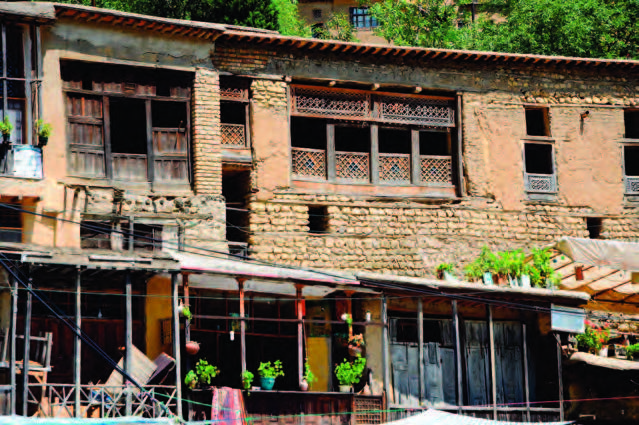
Masuleh, one of the filming locations for Where’s My Friend’s House? (today).
Notes
[1] It would not have been possible to carry out this study without the legacy of Alberto Elena on Abbas Kiarostami that is currently in the Humanities Library of the Carlos III University of Madrid thanks to the donation and generosity of Paloma Garbia.
[2] Own translation of the statements of Abbas Kiarostami in the documentary Abbas Kiarostami: truths and illusions (Abbas Kiarostami, Vérités et songes, Jean-Pierre Limosin, 1994).
[3] Joan Copjec, “Abbas Kiarostami and the Imaginal World, So What?” (Public Readings on Contemporary Humanities and Social Sciences, University of New South Wales: Monday, July 13, 2015). Available at: https://www.youtube.com/watch? V = a12Tbk8NuFI (10/10/2016)
[4] It must be taken into account that the construction of Kiarostami as a neorealist author, the icon of modernity, the follower of a certain humanism, a Kiarostami close to the great European authors such as Rossellini, Bresson, Tarkovski and Antonioni, and even the postmodern Kiarostami occurs at the same time, and even before, the construction of the meaning for Where is my friend’s home? The speculations in search of a category for the Iranian author, in fact, did not begin with this first installment of the trilogy, but, specifically, begin after the second installment: And life goes on. Alberto Elena in the epilogue of his book Abbas Kiarostami (Madrid, Cátedra, 2002), pp. 261-278, reflects on the fact that Kiarostami concepts fluctuated in search of close and recognizable coordinates after the appearance of each of his films at international festivals. Also, regarding these “near coordinates” see Godfery Cheshire, “How to Read Kiarostami” (Cineaste, vol. 25, no. 4, September 2000), pp. 8-15
[5] In 1988 the film participated in the Festival des 3 Continents de Nantes and, as Michel Ciment tells us (“Pourquoi Locarno est-il séduit par l’-Orient” [Positif, no. 344, October 1989] pp. 61-62), went completely unnoticed. In any case, Zaven Gukasian points out that David Streiff, the then artistic director of the Locarno festival, on a trip to Iran in the mid-eighties as a guest of the Farabi Film Foundation, chooses the Kiarostami film among other films for exhibition at Locarno from 1989, where the film receives an award, but still does not attract much attention from critics. See Zaven Ghukasian (ed.), Maymueh-ye maghalat dar nagd va moarrefie asar-e Abbas Kiarostami [Anthology of essays on criticism and presentation of the work of Abbas Kiarostami] (Tehran, Didar, 1375 [1997]), p. 13.
[6] See the dossiers of “Le nouveu cinema iranien” (Positif, no. 368, October 1991), pp. 69-82; and “Abbas Kiarostami” (Positif, No. 380, October 1992), pp. 27-33.
[7] Godfery Cheshire, “How to read Kiarostami”, p. 9
[8] For Cheshire, this Kiarostami reception at Cahiers du cinema (# 493, July-August 1995) was the decisive trigger to set the stage for the Palme d’Or in Cannes. In any case, I use the word “cartography” here in homage to Alberto Elena and his constant emphasis on the fact of cartography of a “new cinema” just discovered at festivals as a continuation of the European ethnographic tradition. See the reference of Manuel d’etnographie de Marcel Mauss in Alberto Elena, “Bollywood new contexts and new publics” (Sequences, no. 36, 2012) p. 16.
[9] Laurent Roth, “Où est la maison de mon ami?”, (Cahiers du cinéma, no. 493, July-August 1995), p. 106.
[10] Actually, it is a double mistake that, above all, must be seen as the case of lost in translation: first, that the word “Friend” was written with capital letters, is a subjective interpretation of Shayegan (translator of the poem), since in Persian, the original language of poetry, there is no capitalization as we know it in languages derived from Latin. Therefore, the word “dust” (friend) in the original version is not highlighted in any way. Second, “dust” is not one of the names of the Prophet Muhammad, nor, in the opinion of the author of this article, is it exactly one of the names of God, but is a form of treatment of an interval space, totally open to the interpretation, in which the bonds of an earthly friendship, a love not necessarily Platonic and a reference to a spiritual freedom outside the scope of religious law merge
[11] The reduction of the meaning of the film to Sepehri’s poem, earlier than in France, had occurred in Iran. After the release of the film in 1988, several authors attributed a certain mysticism to the film, among which Hasan Maleki’s comment, “Shear-e boland-e nab-e Mehr” [“The long and pure Mehr’s poem”] (Abrar, No. 3, Aban 1367 [November 1988]), p. 22.
[12] Youssef Ishaghpour, Le réel, face et pile: Le cinema de Abbas Kiarostami (Farrago, Tours, 2000), p. 69.
[13] Youssef Ishaghpour, Le réel, face et pile: Le cinema de Abbas Kiarostami, p. 71.
[14] Youssef Ishaghpour, Le réel, face et pile: Le cinema de Abbas Kiarostami, p. 71.
[15] Sussan Shams, Le cinema d’Abbas Kiarostami: Un voyage vers l’Orient mystique (Paris, L’Harmattan, 2011), pp. 136-137.
[16] Sussan Shams, Le cinema d’Abbas Kiarostami: Un voyage vers l’Orient mystique, p. 142.
[17] Hamid Dabashi, Close Up: Iranian Cinema, Past, Present and Future (London, Verso, 2001), p. 63, 68-69. Ishaghpour, like Dabashi, points to certain biographical traits from the director’s childhood that point to a certain resemblance between his personality and that of his character Ahmad. See, Youssef Ishaghpour, Le réel, face et pile: Le cinema de Abbas Kiarostami, p. 70.
[18] Interview collected in Jean Mottet (ed.), «Rencontre» in L’arbre dans le payasage, (Seyssel, Éditions Champ Vallon, 2002), pp. 232-234.
[19] Interview collected by Youssef Ishaghpour “La photographie, le cinéma et le payasage”, (ZIN TV, Entretiens avec Abbas Kiarostami). Available at: <http: //www.zintv. org / Entretiens -avec-Abbas- Kiarostami> (12/12/2015).
[20] Interview collected by Bruno Roberti (ed.), Abbas Kiarostami (Rome, Dino Audino Editore, 1996), p. 35.
[21] Perhaps at this time Kiarostami was referring to a verse by Hafez that allegorically encourages the reader to plant the tree of friendship and uproot the weeds of enmity. Hafez’s allegory is not to be confused with the connotations of the tree in Persian culture. See, for example, Shamsoddin Mohammad- e Hafez, Divan-e Hafez (Tehran, Honarsara-ye Guya, 1379 [2000]), p. 124.
[22] Here we must go back to Hafez and note the ambiguity of the term, and that even though the friend is not exactly one of the names of God (see ref. 9), the theme of the Friend, such and as Dariush Shayegan sees it, «it remains the central axis of Hafez’s thought». See Dariush Shayegan, prologue to Sohrab Sepehri, Todo nada, todo mirada (Madrid, Ediciones del Oriente y del Mediterráneo, 1992), p. 19. In any case, it must be clarified here that Alberto Elena’s study continues to be a separate chapter, perhaps because it takes into account the problem of translations, and therefore offers in his aforementioned monographic book Abbas Kiarostami (footnote 82, pp 102-103) additional information on the vision of famous Iranologists about the meaning and importance of the tree, as a secular element, in Persian culture.
[23] Dariush Shayegan, foreword to Sohrab Sepehri, p. 7.
[24] Dariush Shayegan, foreword to Sohrab Sepehri, p. 15.
[25] Dariush Shayegan, foreword to Sohrab Sepehri, pp. 17-18.
[26] Dariush Shayegan, foreword to Sohrab Sepehri, p. 19.
[27] Alberto Elena, Abbas Kiarostami, p. 94.
[28] If there is any alterego game between Ahmad and Kiarostami, it must be sought in this pleasure. Despite the belief and at the same time insistence of international critics on the negative effect of government restrictions on Abbas Kiarostami’s work, the author, in several interviews, has paradoxically denied this negative effect and in turn commented on how censorship has shaped his work, and how a search for an effective strategy not to confront censorship has been a source of pleasure, being the source of his creativity. See, for example, the author’s statements in Abbas Kiarostami: In Conversation with Anthony Sellers at the 13th Galway Film Fleadh (Galway, The Fleadh Papers, 2001), p. 4.
[29] «Wise child» is the term adopted by the author to refer to a certain representation of childhood in Iranian cinema. See, Farshad Zahedi, «The Myth of Bastoor and the Children of Iranian Independent Cinema» (Film International, 2014, vol. 12, No. 3), pp. 21-30.
[30] Emanuela Imparato, «Dov’è la casa del mio amico? – Khaneh – ye doost kojast? » (Cineforum, No. 312, March 1992), pp. 67-68. Cited by Alberto Elena, Abbas Kiarostami, pp. 94-95 and available at: http://www.comune.re.it/cinema/ catfilm.nsf / PES_PerTitolo / 06FF177CC7E0A05BC1256 C0F00509EE1? Opendocument (02/01/2016).
[31] Emanuela Imparato, «Dov’è la casa del mio amico? – Khaneh – ye doost kojast?».
[32] Alain Bergala, Abbas Kiarostami (Paris, Cahiers du cinéma, Le petit Cahiers, Scérén CNDP, 2004), p. 19.
[33] Alain Bergala, Abbas Kiarostami, p. 19.
[34] Alain Bergala, Abbas Kiarostami, p. 19.
[35] Alain Bergala, Abbas Kiarostami, p. 22.
[36] Alain Bergala, Abbas Kiarostami, p. 35.
[37] See Bill Nichols, «Discovering form, inferring meaning: New cinemas and the film festival circuit» (Film Quarterly, 1994, vol. 47, No. 3), p. 17.
[38] Today more than ever it is necessary to return to narratives such as Where is my friend’s house?, as a hymn to solidarity. When the profit logic becomes a universal law of the globalized market and neoliberalism seems to have a certain tendency to be the dominant ideology, to see again the vicissitudes of a child who, above his personal interest, simply looks for the house of his friend to return his notebook and thus avoid the absurd and unnecessary punishment in the classroom, takes on a weight of nostalgia and seems more than ever a heroic deed beyond our reach.
[39] Here it is necessary to clarify two issues. First, when we talk about the pre-ideological space of solidarity, we must point to the historical context of the film. During the war between Iran and Iraq in the 1980’s, at the time of great supply problems due to the isolation of Iran by the West, the sense of solidarity was widely ideologized as a measure of social resistance. Second, within this same framework of solidarity, in the social-educational context of the eighties, in schools throughout the country homework notebooks whose cover design was identical were distributed. That solidarity notebook, whose morphological uniformity leads Ahmad to make the mistake, appears in Kiarostami’s feature film. In one scene, Ahmad picks up the two notebooks to show them to his mother and explains that since the two notebooks are identical, he got confused and brought the two notebooks home. At the last moment, seen from this prism, Ahmad is the quintessential post-revolutionary subject.
[40] For a reading of the pleasure principle and dominant ideology, see, for example, Antonios Vadolas, Pervertions of Fascism (Karnak London, 2009), pp. 92-93.
[41] Here he refers to Kiarostami’s statements: «The film could not be started except through that door (…) This idea of opening the door is essential and fundamental to the film», quoted by Alain Bergala, Abbas Kiarostami, p. 44.
[42] Jean-Luc Nancy, The evidence of the film: Abbas Kiarostami’s cinema (Madrid, Errata naturae, 2008), p. 67.
[43] Shayegan’s comment on Sepehri seems interesting, which in some way can be extrapolated to Kiarostami’s feature film: «[Sepehri] remains outside the currents, the fashionable ideas, the political tendencies that, in a country like Iran, they are too attractive a bait. See Dariush Shayegan, «Foreword to the Sohrab Sepehri» p. 7.
[44] See, for example, Michel Chion, La voz en el cine (Madrid, Catedra, 2004), and Slavoj Zizek, Organos sin cuerpos: sobre Deleuze y sus consecuencias (Valencia, Pre-texts, 2009).
[45] Laurent Roth, «Où est la maison», p. 106.
[46] In some texts the name of the cabinetmaker appears as Mr. Ruhi. It is worth mentioning that in Where is my friend’s home? The name of the cabinetmaker’s character is never revealed, rather it is in the next film, And Life Goes On, when the actor who played the cabinetmaker, whose name is Mr. Ruhi, reappears. In any case, at the end of this sequence, Agajan, before leaving for Koker again, asks his son to go see a certain Turkan, to see if the doors are ready. Moments later, when Ahmad meets the cabinetmaker, he tells him that he knows Nematzadeh and that in fact his son was here a moment ago. Is the cabinetmaker Mr. Turkan? Does Agajan buy the wood doors from the cabinetmaker too to sell them at a higher price? Is the cabinetmaker, despite his complaints and nostalgic vision of the past, Agajan’s business partner?
[47] Very few authors have noticed that the cabinetmaker returns Ahmad to Agajan’s house. A screenshot, offered here, leaves no room for doubt: it is the same house that is now in the dark. It is the same house of the intermediary that Ahmad once contemplated after the tortuous persecution. Here, before the same wall, the same door, and under the same balcony, he was talking to Agajan’s son. The sound of the vendor’s mule bell that once guided Ahmad to find the house, in this reunion, puts an end to the odyssey.
[48] See Alberto Elena, Abbas Kiarostami, p. 107 (footnote 92).
[49] Naser Zeraati, [«Where is my friend’s house: Pleasure of watching a simple and accessible film», Khaneh-ye doost kojast: lazaat bordan az filmi sahl va momtane], (Donya-ye sojan, no. 23, chance 1367 [November 1988].
[50] Bill Nichols, «Discovering Form», p. 16.
[51] The term comes from the famous book by Noël Burch, To the Distant Observer: Form and Meaning in the Japanese Cinema (Los Angeles, University of California Press, 1979).
[52] Bill Nichols, «Discovering Form», p. 17.
[53] Monika Raesch, The Kiarostami Brand: The Creation of a Film Author (Berlin, Lambert Academic Publishing, 2009).
[54] Antonio Weinrichter, «Geopolitics, festivals and the Third World: Iranian cinema and Abbas Kiarostami» (Archives of the Filmoteca No. 19, February 1995), pp. 29-36.
[55] Monika Raesch, The Kiarostami Brand: The Creation of a Film Auteur (Berlín, Lambert Academic Publishing, 2009).
[56] Monika Raesch, The Kiarostami Brand.

